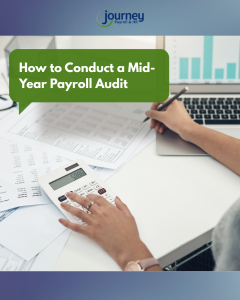Mid-year is the perfect moment to give your payroll a tune-up. You’ve accumulated enough data to spot trends, but you still have time to fix issues before year-end taxes, bonuses, and open enrollment pile on. Think of this as preventative maintenance for your business: a few focused checks now can protect cash flow, employee trust, and compliance later.
Start with the People: Clean Employee Records
 Begin where most payroll problems begin employee data. Confirm that names, addresses, and Social Security numbers are accurate, and that pay rates and job titles match current offers and promotions. While you’re there, revisit classifications: are your exempt vs. non-exempt decisions still correct? Are any “contractors” functioning like employees, particularly in hybrid or long-term roles?
Begin where most payroll problems begin employee data. Confirm that names, addresses, and Social Security numbers are accurate, and that pay rates and job titles match current offers and promotions. While you’re there, revisit classifications: are your exempt vs. non-exempt decisions still correct? Are any “contractors” functioning like employees, particularly in hybrid or long-term roles?
Pro tip: Compare HR files to what’s in your payroll system. Small onboarding discrepancies, like a missing apartment number or a title change that never got updated—often cascade into bigger errors.
Pressure-Test Wage & Hour Practices
Next, take a hard look at how hours translate into pay. Are overtime calculations correct every time? Do your meal and rest break policies show up properly on paychecks? Are you comfortably above state and local minimums (which may have changed mid-year)?
Watch for red flags: identical gross pay amounts week after week for hourly employees, round-number time entries that ignore real-world variance, or timecards regularly approved late. Those patterns often signal misconfigurations or worse, noncompliance.
Make Benefits Deductions Boring (That’s a Good Thing)
Benefits should be predictable and precise. Confirm that 401(k) deferrals, HSA/FSA contributions, and health insurance premiums are calculating as expected, and that pre-tax vs. post-tax coding is correct. If you offer employer matches, verify they’re funding on time and to the right accounts.
Pro tip: Pull a report from your benefits providers and cross-check it against payroll deduction history. A quick reconciliation now prevents messy correction files later.
Match Withholdings to Reality
Taxes are where good intentions meet math. Spot-check federal, state, and local withholdings for a sample of employees with different jurisdictions and pay frequencies. Ensure employer taxes—FUTA, SUTA, local payroll taxes are being calculated and deposited on schedule. Then reconcile what employees see on their paystubs with what you’ve reported on your quarterly filings (like Form 941). If those don’t align, fix the root cause now rather than at year-end.
Sanity-Check PTO and Leave Balances
Time off is both a compliance requirement and a culture signal. Confirm that accruals match your policy and any applicable laws, and that balances make sense for tenure and usage. Negative balances or unusually large unused banks can indicate a configuration problem or a manager approval bottleneck. For protected leaves (sick leave, FMLA or state equivalents), make sure documentation is in order and payroll codes are applied consistently.
Pro tip: Run a mid-year PTO report and share insights with managers. It’s a simple way to reduce end-of-year scheduling crunches.
Look Under the Hood of Your Payroll System
Your platform may be “set and forget,” but business isn’t. Check that pay schedules are current, new earning codes are configured correctly, and any automation rules still match policy. If you issued mid-year raises or reclassifications, confirm the effective dates and rates actually changed in the system (and retro pay was handled correctly when needed). Review recent software updates or vendor bulletins there may be new features or regulatory changes you should enable.
Close the Loop: Document, Fix, Prevent
Wrap your audit by writing down what you reviewed, where you found issues, and the corrections you made. Capture root causes like unclear handoffs between HR and payroll or a missing approval step and adjust your process so the same mistakes don’t reappear. Put a follow-up check on the calendar before year-end to make sure improvements stuck and to catch anything new.
The Bottom Line
A mid-year payroll audit isn’t busywork it’s risk management. Done well, it protects your employees, your compliance posture, and your year-end sanity. And if you partner with a payroll provider, this is the ideal time to schedule a check-in and ensure your configuration, deductions, and filings are all dialed in.